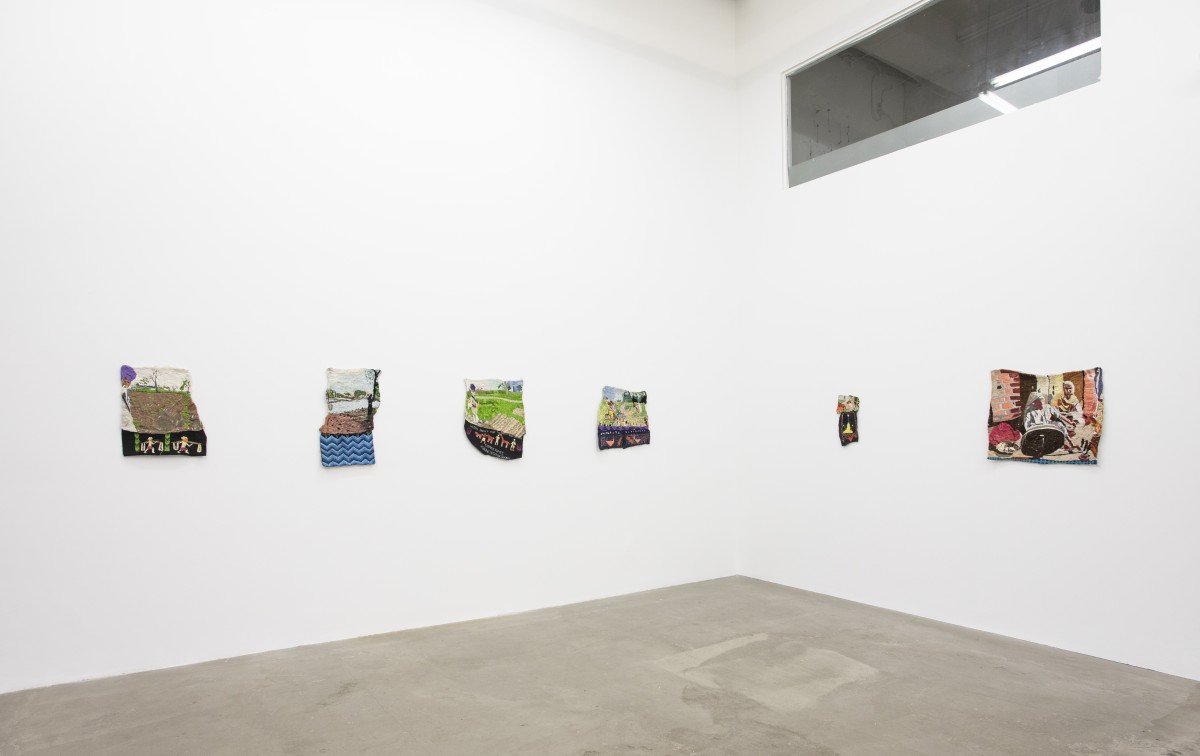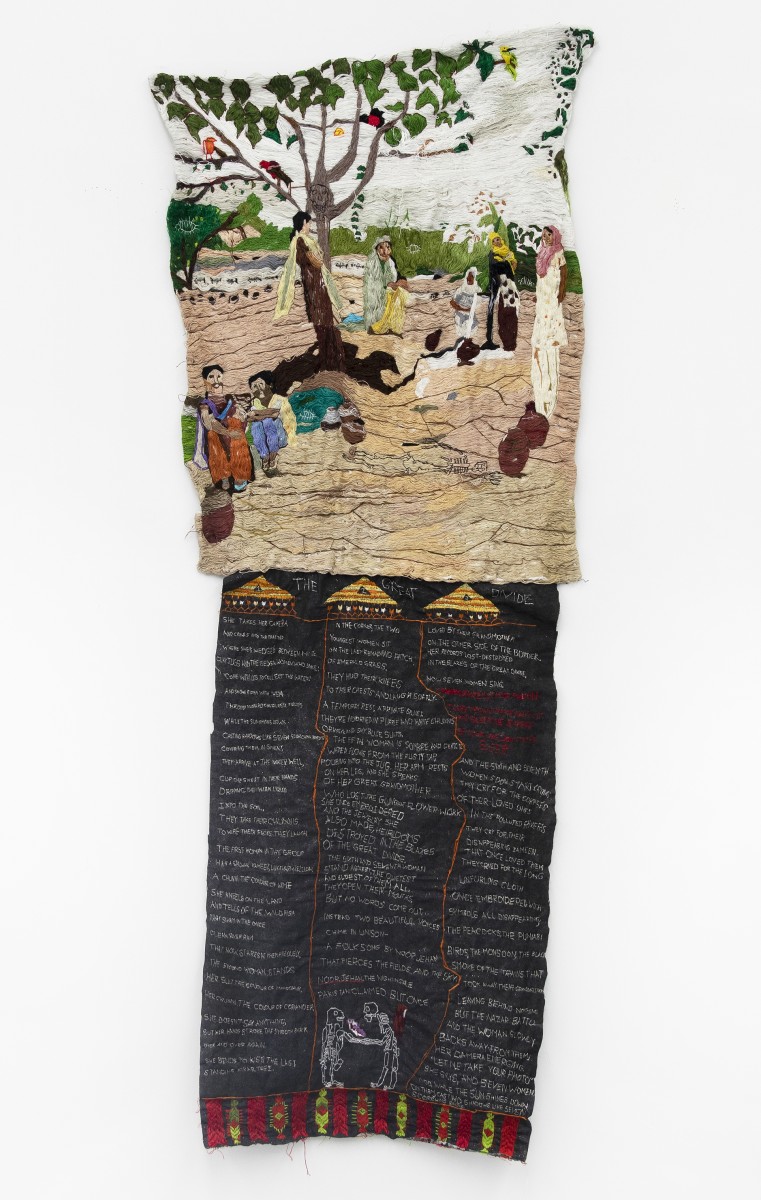weaving the Green Revolution
A new solo exhibition by artist Jagdeep Raina explores the impacts of the Green Revolution in Punjab – on view now at Cooper Cole Gallery in Toronto.

Installation view of Jagdeep Raina’s Beautiful Zameen at Cooper Cole, 24 September – 29 October 2022.
A new exhibition by contemporary artist Jagdeep Raina exploring the Green Revolution in Punjab is on view now at Cooper Cole Gallery. Beautiful Zameen – meaning beautiful land – spans two Cooper Cole locations in Toronto, and consists of Raina’s signature drawings and embroidery. The exhibition reflects on the impact of the Green Revolution – a U.S.-sponsored agricultural framework implemented in the Punjab state of India in the 1960s, leading to damaged landscapes, widespread soil erosion, and subsequently, an epidemic of farmer suicides. Raina has studied the topic extensively since 2018.
Like much of Raina’s work, Beautiful Zameen embodies the material history of South Asia. Most of the embroidered works in the exhibition are surrounded by borders made in a traditional Pulkari weaving style. Alongside the works, Raina has included a letter by film artist Hasabie Kidanu containing heartfelt insights about the exhibition and Raina’s practice at large.
We recently connected with Raina to find out more about Beautiful Zameen, the Green Revolution, and Pulkari weaving.
AGOinsider: When did you first become interested in and begin researching the Green Revolution in Punjab? How did that interest evolve into an artistic expression?
Raina: I first started seriously thinking about wanting to research the Green Revolution in 2018. I was becoming increasingly inspired to explore environmental histories in my work and think about the ways in which migration ruptures communities' relationship to the land; how environmental knowledge is lost and how it can be resurrected in new, fragmented ways. Learning about farmers passing away by suicide in Punjab was something that I know I really wanted to understand as an artist, and do it in a way that felt it was done with care, tenderness and integrity. I drew inspiration from scientists and engineers like Bandana Kaur Malik's Masters thesis at the Yale School of Forestry and Environmental Studies: Green Revolutions Revisited: Women, Biodiversity, and Folk Knowledge in Rural Punjab, the film Punjab: Land of the Five Drying Rivers by Sirjaut Kaur Dhaliwal, and eventually reading the play by Satinder Chohan, entitled Zameen. It took me a while to figure out how to approach my own relationship towards how to talk about this history, and eventually I found myself drawn to the world of textiles, poetry, animated films, quilts, and drawings as a way to explore it. I always turn to the wise words of Nalini Malani who says: How can human pain and social suffering, past and present be rendered visually in such a way that its representation nurtures and illuminates life, rather than indulging in aesthetic stylization, voyeuristic titillation, or succumbing to fatalism in the face of mythic cycles of violence?
AGOinsider: Can you share some details and insights about your time studying the playwright Satinder Chohan’s photography of the Green Revolution?
Raina: My time studying Satinder's photographic archive began in 2019, when we spent a day together in Southall – a large, thriving immigrant community in the outskirts of West London – where she spoke to me about her experiences writing the play Zameen and building an archive of recordings, photographs and videos from the mid-2000s. Eventually Satinder passed on her archive to me for safeguarding, and I slowly started exploring it, thinking about the materiality of her research and how to resurrect it in an artistic lens. I turned to the long lineage of artists who have come before me who have also drawn on the archive for inspiration; artists such as Thomas Hirschhorn, Leslie Hewitt, Mamma Andersson, John Akomfrah and Gerhard Richter to name a few.
AGOinsider: Most of the tapestries in the show are surrounded by a Pulkari border. Can you elaborate on the significance of the traditional weaving style and its place in your practice?
Raina: The phulkari is an ancient, embroidered textile that hails from Pujnab which I have been studying. The silk floss used to come from Kashmir – a region in Northern India/Pakistan that my family hails from – and a region that borders Punjab. In 2019, I took a phulkari workshop with Oakville, Ontario-based artist Rafia Shafiq and did a two-week residency in Lahore, Pakistan where I continued to immerse myself in phulkari embroidered techniques, while also looking at Kashmiri Shawls and Phulkaris found in various museum collections: the Royal Ontario Museum, the Minneapolis Institute of Art, and phulkaris and Kashmiri shawls in the private homes of kashmiri and Punjabi families.
AGOinsider: Artist Hasabie Kidanu has written a letter that accompanies Beautiful Zameen. In it, she shares heartfelt insights about the show, and your practice at large. Can you share some of your thoughts about this letter, and your choice to include it in the exhibition?
Raina: Inviting Hasabie Kidanu to write a letter for the exhibition was such a joy to do. I've always been inspired by Has's work, the way in which she probes memory to understand how it can be translated into a material practice, her approach to viewing history as something that one can revisit and that holds a space for ideas still feeling unresolved, exploring fictional/nonfictional landscapes, and her relationship to literature and cinema has always been an inspiration for me as an artist. Giving her full creative freedom to draw from this body of work and write a text has been such a fulfilling collaboration. I am so grateful to Has.
Beautiful Zameen is on view until October 29 at Cooper Cole Gallery.

